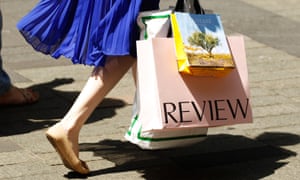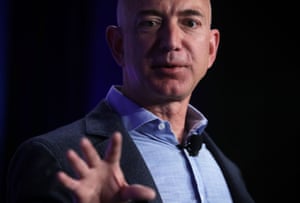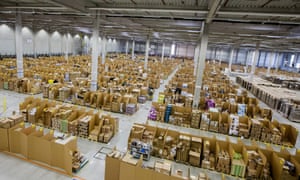
Down Dandenong way, on the outskirts of Melbourne, Amazon is staking out a beachhead for the invasion.
Strategically located near freeway connections to Australia’s busiest cargo seaport, the US$465bn retail superpower’s cavernous new fulfilment centre is gearing up to house hundreds of thousands of products shipped in from all over the world.
Citibank analysts predict Amazon will hit Australia in October, although the business itself is tight-lipped about the details. In the lead-up this 24,000 square metre warehouse is shedding the red-and-green branding of former tenant Bunnings for Amazon yellow, as it gears up to serve as a staging ground for a highly automated online retail operation that has deftly outmanoeuvred competitors, unions and tax authorities all over the globe – and promises to unleash the biggest disruption to the Australian market since the rise of department stores.
The incoming arrival of Amazon has seen the share value of major Australian retailers plunge, with local business leaders only helping fuel the panic. Amazon this year has been variously described as “the worst possible corporate citizen”, “Attila the Hun”, “a parasite” that “pays no tax” and threatens to “send everyone broke” – and that’s just by Gerry Harvey, the chairman of the electrical retail chain Harvey Norman, which in May had its profit forecasts downgraded by 30% by Citibank after analysis of Amazon’s impact in the US.
The colourful entrepreneur’s rhetoric has struck some as a little rich: the Retail Global founder, Phil Leahy, observed that Harvey’s “contradictions are breathtaking, given he has beaten competitors in building his own empire”.
Formerly the backbone of the Australian economy, small businesses were eaten up during the latter half of the 20th century by franchise-packed shopping centres and towering superstores like those of Harvey Norman that offered lower prices and greater range in a single location.

Back then it was a matter of profits being sucked from communities out to Sydney head offices. Harvey’s warning is that Amazon might just whisk the earnings out of Australia entirely as it undercuts local rivals by producing at greater scale – just as Australia’s big retailers once did to independent stores. The e-commerce giant generates nearly as much revenue as Australia’s supermarket duopoly of Wesfarmers-owned Coles and Woolworths combined, and Morgan Stanley estimates the company will generate $12bn of Australian sales by 2026.
Just as a single superstore visit suited consumers more than visiting a medley of small businesses, Amazon’s all-encompassing product range and rapid response time represents another level of convenience again: the company guarantees delivery in some areas of the US within two hours of customers clicking through to the online checkout.
Underpinning it all is Amazon’s pioneering of the latest technologies – robots that whisk shelves around warehouses, delivery drones that could soon zoom out of beehive towers and scan the properties of customers to see if there is anything else they might need, a voice-activated virtual assistant that can recommend what to buy (not to mention critique the outfits of users) and an Amazon Prime membership package that comes with a streaming video service to rival Netflix.
Harvey says his company is up for the fight and that Amazon’s roll out cannot be as quick as expected but many Australian retailers aren’t aware there is going to be a fight in the first place. In March a Commonwealth Bank survey of more than 600 retailers found only 41% thought Amazon would be a threat to their business.
The consumer behaviour analyst Barry Urquhart, the Perth-based managing director of Marketing Focus, is embarking on a speaking tour about the scale of the Amazon challenge. He says: “Australian retailers are unprepared, ill-informed and don’t know what they are going to address. I don’t think they appreciate what Amazon is. A lot of people are confused. They think, ‘I’m protected, I don’t sell books and CDs.’ But Amazon is a platform, like Uber, and we saw what Uber did to taxis.”
The complacency might be to do with Amazon’s existing presence in Australia, where it has sold a limited range of entertainment-related products since 2012. Amazon’s full suite of offerings cover just about any product imaginable, from auto parts to furniture to sports gear. In June the company even committed to the bricks-and-mortar supermarket world with the US$13.7bn purchase of organic food chain Whole Foods – a sign that it will be ready to take part in the supermarket wars of Coles v Woolworths v Aldi.
Amazon took on half of all e-commerce sales growth in the US last year and has piled huge pressure on American retailers, which are closing at record pace: 2017 is on track for over 8,500 store closures, dwarfing the 6,200 that shut their doors during the recession-hit turbulence of 2008.
With American brands such as Sears and Macy’s shuttering hundreds of shopfronts alone, malls are struggling to find tenants. In a sign of the times, an Ohio mall that was the largest in the world is being transformed into an Amazon fulfilment centre.
An Institute of Local Self-Reliance report – published late last year before the 2017 retail apocalypse – calculated that Amazon has eliminated about 149,000 more jobs in retail than it has created in its warehouses. The company’s embrace of automation is anticipated to further increase that gap, including the roll out of cashier-free physical stores where customers can walk out with their shopping while the payment is taken care of automatically through their Amazon account.
A UBS survey found that Amazon’s arrival in Australia is predicted to eat up 16% of retailers’ discretionary earnings within five years, including 31% of department store giant Myer.
The company is undertaking new measures as Amazon arrives, including the trial of a new yellow-branded clearance section in stores and enhancing its online marketing by leveraging data collected on shoppers via its loyalty program.
In June the Myer chief executive, Richard Umbers, revealed the company would focus on offering unique brands. “I reckon that really dialling up the newness, the uniqueness of our range and in particular products that aren’t available on Amazon anyway … is the right way to defend ourselves against Amazon,” he told the Australian.
Union hostility
The National Union of Workers’ national secretary, Tim Kennedy, says the union wrote to Amazon in mid-August seeking a meeting to discuss plans for Australia but never heard back.
He says a failure to engage will fit with Amazon’s record of poor labour practices.
“These include the electronic monitoring of workers and harassment to the detriment of safety,” he says. “There is a well known case of the warehouse in Allentown, Pennsylvania, where workers are forced to work in extreme heat and when people drop they are whisked into ambulances that are stationed in the car park to remove them and replace the worker with standby workers on site ready to fill the hole. Quite shocking really. No respect for the essential humanity of people.”
The scandal, which was reported in 2011, came about because the facility did not have air conditioning and Amazon did not want to leave the doors open for fear of merchandise being stolen. The company has since invested in air conditioning across a number of fulfilment centres, including at the planned Melbourne facility.
Asked to respond to Kennedy’s concerns, Amazon spokesman James Lewis told the Guardian in an email that Amazon’s fulfilment centres are “a great place to learn skills to start and further develop a career”.
Lewis said the safety of workers was the company’s top priority and that “as with most companies, we have certain expectations regarding the performance of associates. Productivity targets are set objectively, based on previous performance levels achieved by our workforce and evaluated over a long period of time. The vast majority of our fulfilment centre associates perform very well. If an associate is not meeting these performance levels, managers will work in consultation with associates in an endeavour to find a solution.”
Amazon has a long and successful track record of pressuring employees to avoid unions, going right back to the year 2000 when leaked company documents detailed strategies to warn workers that unions are an expensive waste of time and telling supervisors to watch out for union activity signs such as “hushed conversations” among workers and “dawdling in the lunchroom and restrooms”.
Lewis did not respond to the Guardian’s question about whether Amazon would meet with the NUW. Asked if Amazon would allow employees the option to join unions – as required by Australian law – Lewis said: “We respect the individual rights of our associates and have an open-door policy that encourages associates to bring their comments, questions and concerns directly to their management team. We firmly believe this direct connection is the most effective way to understand and respond to the needs of our workforce.”

Investigations in the US and Europe have painted a detailed picture of what working at Amazon can entail. Half-hour unpaid breaks are partly eaten up by the time it takes to enter and exit fulfilment centres, which at some locations require queuing up to be searched for stolen contraband as nearby televisions loop a rogue’s gallery of silhouetted former employees fired for stealing.
Employees are discouraged from using the bathroom and allocated demerit points for taking too long. They also lose points for taking sick days – examples include a worker penalised for being hospitalised with a kidney infection and another who was put on performance review for allowing breast cancer treatment to impede her work.
At the corporate end, white-collar workers are pitted against each other and encouraged to rat on their peers via an anonymous assessment tool that ranks employees for the purposes of an annual cull. Workers have reported receiving midnight emails immediately followed by text messages asking why there hasn’t been a reply.
Aside from the issue of fewer retail workers meaning fewer people paying taxes, Amazon itself has been questioned over its own tax contributions around the world.
The most recent controversy came from the company paying just €16.5m in tax on European revenues of €21.6bn in 2016 through the low-tax jurisdiction of Luxembourg.
The multinational tax avoidance expert Antony Ting, an associate professor at the University of Sydney Business School, says: “This kind of structure is common among e-commerce multinational enterprises such as Google, Facebook, Uber and Airbnb. The core of these tax arrangements is to locate intellectual properties (eg the digital platforms) to a low-tax jurisdiction (eg Bermuda), thus justifying shifting profits to that country. For these digital companies, these intangible assets, which are extremely mobile, are often their most important and valuable assets.”
Ting notes Amazon will be encountering some specific challenges to its business model in Australia in the shape of the multinational anti-avoidance tax law (MAAL), introduced in January 2016, and the diverted profits tax (DPT), which came into force in July. He says the MAAL has had some success in securing tax revenues out of Facebook and Google, with the former increasing Australian profits by a factor of 10 and Google more than doubling local profit.
Ting notes the MAAL appears to still fall a significant way short of securing tax revenues in line with the global profit margins of these companies – Facebook Australia’s net profit margin was 1% compared with a global net profit margin of 37%.
As for the DPT, he says it might further improve tax intakes from multinationals like Amazon but, as it has only just been introduced, it is difficult to predict the outcome.
“As the MAAL has been in place for over a year, it is likely that the corporate structure of Amazon in Australia will be designed in accordance with MAAL,” he says.
In response Lewis said: “Amazon pays all the taxes we are required to pay in every country where we operate. Corporate tax is based on profits, not revenues, and our profits have remained low given our heavy investments and the fact that retail is a highly competitive, low-margin business.”
Opportunities for consumers and small businesses
Gigi Foster, an associate professor at the University of New South Wales business school, says she is “broadly optimistic” about the impact Amazon will have on Australia.
“There is the potential for positive effects on Australian consumers, who have languished because of restrictions on imports,” she says. “I think it’s great you will have the option to buy a lot more stuff, people will be happier because of that. The more you can buy, the happier you can make yourself and your family.”
Foster acknowledges there could be problems for Australian retailers, suggesting that small enterprises need to make sure they stock niche products not available on Amazon.

Independent retailers that have survived through the era of big department stores are now bracing themselves for this new challenge. That includes Warren’s Menswear, an independent store in Fremantle that has been trading since 1931.
The manager of Warren’s Menswear, Teresa Serafini, says: “Competition is great but not when Amazon can undercut you so you can’t compete. But we offer service that Amazon can’t and people remember that. We’ve survived through the great depression, a world war, the rise of retail chains. We get people who come in and say, ‘Oh my dad and before him my grandfather used to come here’.”
Back at Marketing Focus, Urquhart says that kind of community relationship could see small businesses cope better with Amazon than the very retail chains that used to threaten their future.
“You look at a big retailer like Officeworks where people are buying consumables,” he says. “If customers can go on to Amazon and get something functional for cheaper, they will start buying their USBs, calculators and pens from there. Small businesses, however, can easily live with and beat Amazon simply by providing personal interactive experiences – loyalty to the individual rather than the product.”
Analysts have also noted that small enterprises offering unique products could benefit by selling their products through Amazon, using its formidable logistics capability to deliver to a huge global user base.
The lack of awareness among Australian retailers about what Amazon actually represents is a major obstacle to this happening, however, as seen by the case of the 175-year-old Oliver’s Taranga Vineyards in South Australia, one of the country’s oldest family businesses.
The Oliver’s Taranga Vineyards sales manager, Nicky Connolly, recently attended a marketing industry seminar in Sydney where Amazon was a hot topic but she left the conference still unaware that the American giant sells wine, with all the competition and potential supply opportunities that represents.
“Oh, I didn’t know Amazon do wine now,” she tells the Guardian, pausing for a moment. “They’re not just books anymore, are they?”
No comments:
Post a Comment